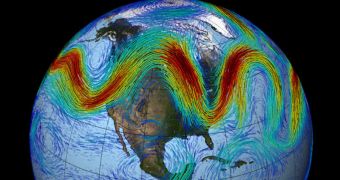Scientists with the Institute of Marine and Coastal Sciences at the Rutgers University, led by professor Jennifer Francis, announce in a new study that higher temperatures in the Arctic – caused by global warming – appear to be a huge influence on the high-altitude conveyor belt known as the jet stream.
This atmospheric feature is a fast-flowing, narrow air current that flows near the tropopause. This is an area of the atmosphere that lies at the boundary between the troposphere and the stratosphere. One of its main characteristics is that it can meander through the air, and split into multiple segments before reuniting and proceeding on its way.
There are several jet streams on Earth, but one in particular – located in the northern hemisphere – is responsible for controlling weather patterns over North America and parts of Europe. Just a few decades ago, parts of the United States experienced rapidly-shifting weather patterns created by the jet stream. Now, researchers are noticing that the weather is changing less often than it used to.
Francis say that weather system produced by the jet stream now remain over the same area for longer periods of time. In a new study, she argues that this effect is most likely a consequence of the warming Arctic. The expert held a presentation on the issue on Saturday in Chicago, at the annual meeting of the American Association for the Advancement of Science, NPR reports.
Changes in the way the jet stream flows over the North America could explain why such severe winter phenomena were recorded in the United States and Canada over the past few years. Francis said at the AAAS meeting that this shift might also help explain the multi-year drought affecting California.
“We can expect more of the same and we can expect it to happen more frequently. The Arctic has been warming rapidly only for the past 15 years. Our data to look at this effect is very short and so it is hard to get a very clear signal,” said Francis, who argues that it is too early to tell if the Arctic warming is caused by humans or natural phenomena.
“Fundamentally, the strong warming that might drive this is tied in with the loss of sea-ice cover that we're seeing, because the sea-ice cover acts as this lid that separates the ocean from a colder atmosphere. If we remove that lid, we pump all this heat up into the atmosphere,” said Mark Serreze.
“That is a good part of the signal of warming that we're now seeing, and that could be driving some of these changes,” concluded the expert, who holds an appointment as the director of the US National Snow and Ice Data Center (NSIDC). He was also a member of the AAAS panel with Francis.

 14 DAY TRIAL //
14 DAY TRIAL //